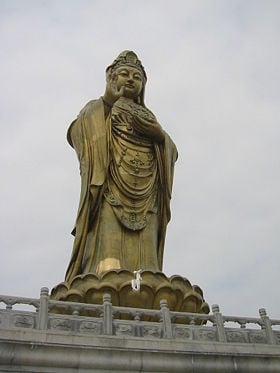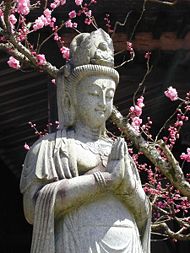Guan Yin
Kuan Yin (traditional:觀音; simplified:观音; Pinyin: Guān Yīn) is the bodhisattva of compassion as venerated by East Asian Buddhists, almost exclusively as a female. Kuan Yin originated as the Sanskrit Avalokiteśvara, which is her male form. Commonly known in the West as the Goddess of Mercy, Kuan Yin is also revered by Chinese Taoists as an Immortal. The name Kuan Yin is short for Kuan Shih Yin (Pinyin: Guān Shì Yīn) which means "Observing the Sounds of the World".
In Japanese, Kuan Yin is called Kannon or more formally Kanzeon; the spelling Kwannon, based on a pre-modern pronunciation, is sometimes seen. In Korean, this incarnation of Buddha is called Gwan-eum or Gwanse-eum, and in Vietnamese, the name is Quan Âm or Quan Thế Âm Bồ Tát.
Depiction
Kuan Yin is the Chinese name for the Bodhisattva Avalokiteśvara. However, folk traditions in China and other East Asian countries have added many distinctive characteristics and legends. Avalokiteśvara was originally depicted as Buddha when he was still a prince, and therefore wears chest-revealing clothing and may even sport a moustache. However, in China, Kuan Yin is usually depicted as a woman.
In China, Kuan Yin is usually shown in a white flowing robe, and usually wearing necklaces of Indian/Chinese royalty. In the right hand is a water jar containing pure water, and in the left, a willow branch. With these Kuan Yin is thought to control the weather, heeding the pleas of the desperate and alleviating drought. Her crown usually depicts the image of Amitabha Buddha, Kuan Yin's spiritual teacher before she became a Bodhisattva. Many images of Kuan Yin present her with an extraordinary number of arms, hands, and eyes, representing her role as the observer and protector of the unfortunate.
She is occasionally flanked by her two acolytes, who appeared to her when meditating at Mount Putuo, Long Nü and Shan Tsai. Shan Tsai (Pinyin: Shancai) is especially associated with Kuan Yin's role of granting children and wealth, being thought of as a "God of Wealth" in his own right. A story from the Yuan Dynasty indicates he rejected fifty-three human teachers and was content on being only Kuan Yin's disciple. He is often found on Kuan Yin's left in temple statues and paintings.
History
Along with Buddhism, Kuan Yin's veneration was introduced into China as early as the 1st century CE, and reached Japan by way of Korea soon after Buddhism was first introduced into the country from the mid-7th century.
Representations of the bodhisattva in China prior to the Song Dynasty (960-1279) were masculine in appearance. Images which later displayed attributes of both genders are believed to be in accordance with the Lotus Sutra, where Avalokitesvara has the supernatural power of assuming any form required to relieve suffering and also has the power to grant children. Because this bodhisattva is considered the personification of compassion and kindness, a mother-goddess and patron of mothers and seamen, the representation in China was further interpreted in an all female form around the 12th century. In the modern period, Kuan Yin is most often represented as a beautiful, white-robed woman.
Attributes
Kuan Yin is primarly known as the Goddess of Mercy; compassion is her primary attribute. However, over time other attributes have been linked with this bodhisattva, often related to her role as the compassionate observer of the world. Kuan Yin's role was expanded to granting children and wealth when she was introduced to China, as these were requests made often by her devotees. Due to her symbolising compassion, in East Asia Kuan Yin is associated with vegetarianism. Chinese vegetarian restaurants are generally decorated with her image, and she appears in most Buddhist vegetarian pamphlets and magazines.
Legends
Kuan Yin and the Thousand Arms
One Buddhist legend presents Kuan Yin as vowing to never rest until he had freed all sentient beings from samsara. Despite strenuous effort, he realized that still many unhappy beings were yet to be saved. After struggling to comprehend the needs of so many, his head split into eleven pieces. Amitabha Buddha, seeing his plight, gave him eleven heads with which to hear the cries of the suffering. Upon hearing these cries and comprehending them, Avalokitesvara attempted to reach out to all those who needed aid, but found that his two arms shattered into pieces. Once more, Amitabha came to his aid and appointed him a thousand arms with which to aid the many. Many Himalayan versions of the tale include eight arms with which Avalokitesvara skilfully upholds the Dharma, each possessing its own particular implement, while more Chinese-specific ones give varying accounts of this number.
In China, it is said that fishermen used to pray to her to ensure safe voyages. The titles Kuan Yin of the Southern Ocean (南海觀音) and 'Kuan Yin (of/on) the Island' stem from this tradition.
Legend of Miao Shan
Another story, possibly Taoist in origin, describes Kuan Yin as the daughter of a cruel father who wanted her to marry a wealthy but uncaring man. She is known as Miao Shan (妙善), and her father's realm allegedly Sumatra. She begged to be able to enter a temple and become a nun instead. Her father allowed her to work in the temple, but asked the monks to give her very hard chores in order to discourage her. The monks forced Kuan Yin to work all day and all night, while others slept, in order to finish her work. However, she was such a good person that the animals living around the temple began to help her with her chores. Her father, seeing this, became so frustrated that he attempted to burn down the temple. Kuan Yin put out the fire with her bare hands and suffered no burns. Now struck with fear, her father ordered her to be put to death. After she died she was made into a goddess for all of her kindness and began her journey to heaven. She was about to cross over into heaven when she heard a cry of suffering back on earth. She asked to be sent back and vowed to stay until all suffering had ended.
One version of this legend states that, at the point of Kuan Yin's father's execution of her, a supernatural tiger took Kuan Yin to one of the more hell-like realms of the dead. However, instead of being punished by demons like the other inmates, Kuan Yin played music and flowers blossomed around her. This managed to completely surprise the head demon. The story says that Kuan Yin, by being in that hell, turned it into a paradise.
Another version of the same legend goes that upon entering hell Kuan Yin was overwhelmed with grief at the suffering souls must endure in hell. Out of compassion, she freed many of the souls from hell before being stopped by Yanluo, King of Hell. She then returned back alive on Earth and resided at Mount Putuo.
Another tale goes that Miao Shan never died but was in fact transported by a supernatural tiger, believed to be the Diety of the Place to Fragrant Mountain.
The Legend of Miao Shan usually ends with Miao Chuang Yen, the father of Miao Shan falling ill with jaundice. It is said that no physician could cure him. Then a monk appeared saying that the jaundice can be cured by making a medicine out of the arm and eye of one without anger. The monk further suggested that such a person could be found on Fragrant Mountain. Miao Shan when requested offered up her eyes and arms willingly. Miao Chuang Yen was cured of the illness and went to the Fragrant Mountain to give thanks to the person. When he discovered that his own daughter gave up her arm and eyes for him, he begged for forgiveness. The story concludes with Miao Shan being transformed into the Thousand Armed Kuan Yin and the king, queen and her two sisters building a temple on the mountain for her.
ReferencesISBN links support NWE through referral fees
- Martin Palmer, Jay Ramsay, Man-Ho Kwok: Kuan Yin. Myths and Prophecies of the Chinese Goddess of Compassion. , Thorsons, San Francisco 1995, ISBN 1855384175
External links
- Kuan Yin, The Compassionate Rebel has a detailed anthropological analysis of the evolution of Kuan Yin, as well as a full explanation of the legend of Miao Shan.
Credits
New World Encyclopedia writers and editors rewrote and completed the Wikipedia article in accordance with New World Encyclopedia standards. This article abides by terms of the Creative Commons CC-by-sa 3.0 License (CC-by-sa), which may be used and disseminated with proper attribution. Credit is due under the terms of this license that can reference both the New World Encyclopedia contributors and the selfless volunteer contributors of the Wikimedia Foundation. To cite this article click here for a list of acceptable citing formats.The history of earlier contributions by wikipedians is accessible to researchers here:
The history of this article since it was imported to New World Encyclopedia:
Note: Some restrictions may apply to use of individual images which are separately licensed.


